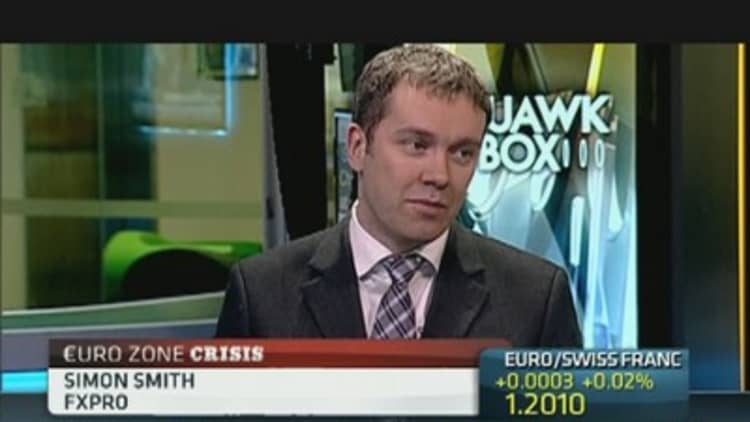The euro is hovering close to the crucial 1.20 level against the dollar — and analysts warn it will fall even further without further intervention by euro zone authorities.
The currency could sink to 1.15 or even 1.10, Peter Whitley, senior FX analyst at Thomson Reuters, told CNBC’s “Capital Connection” Tuesday.
“The downside has picked up steam and rallies are scarcer and scarcer,” he said. “Spain is the main focus — everything else is secondary. The ECB seems to have too many balls in the air. If the euro goes through 1.20, there’s not much stopping it on the downside.”
The possibility that rather than a bailout of its banking system has sent tremors through European markets this week and pushed Spanish 10 year bond yields above the alarming 7.5 percent level (related:the world's biggest debtor nations).
Tuesday’s flash euro zone PMI data suggested that the recession will continue, adding to the gloom around the region.
“The markets sense that we are not going to have one of those quiet summers where politicians go away and we can sort of forget about it, certainly what we are seeing in Spain is reaching a critical level,” Simon Smith, chief economist at FXPro, told CNBC’s “Squawk Box Europe” Wednesday.

The currency’s lowest ever point against the dollar came in October 2000, when it hit 82 cents – although this was before the single currency’s coins and notes were minted. It is currently skirting the 1.20 level, not far from the recent June 2010 low of $1.1875.
A weaker euro might actually benefit euro zone policymakers, Simon Grose-Hodge, head of investment advisory at LGT Bank in Singapore, told CNBC.
“We haven’t heard a single word expressing concern about the drop in the euro. Every policy response seems to imply that we need a weaker euro – and on a long-term basis, it’s not that weak,” he said.
The monetization of debt — one of the options on the table for the euro zone and more simply known as money-printing — is likely to lead to future weakness in the euro, he argued.
The euro will continue to fall against the dollar, with a move to 1.20 “likely,” currency analysts at Lloyds wrote in a research note Wednesday.
“The biggest problem with the euro is we have to keep changing our forecasts for the worse,” Grose-Hodge said.



